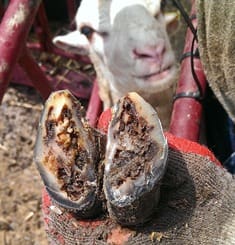 WESTERN New South Wales landowners have been warned to insist on animal health statements for purchased or agisted sheep, following footrot outbreaks in central western NSW.
WESTERN New South Wales landowners have been warned to insist on animal health statements for purchased or agisted sheep, following footrot outbreaks in central western NSW.
Local Land Services Western Region is encouraging the region’s producers to be vigilant, to only bring stock onto their properties from reputable sources, and request and carefully examine health statements before stock movements occur to avoid the introduction of disease. The unusually wet conditions currently being experienced in many areas increase the risk of expression and spread of the disease.
Bourke-based NSW Department of Primary Industries veterinarian Dr Charlotte Cavanagh said reports have emerged recently in areas that have not seen the notifiable disease in decades and it may come as a nasty surprise to some graziers.
“It is likely that the increased prevalence of this disease is due to people buying in sheep with footrot and has been exacerbated by the prolonged wet weather.
“The cases of virulent footrot diagnosed by Local Land Services veterinarians in the central west are right on the doorstep of the Local Land Services Western region,” Dr Cavanagh said.
“Western producers wanting to take advantage of the fantastic season we are having out here, should be aware that we are not immune to these types of diseases if conditions are right.
“Footrot is debilitating for stock and expensive and labour intensive to eradicate. It is a good idea to isolate newly introduced stock and ensure they are healthy, with no signs of lameness, before introducing them to the main mob.”
Properties diagnosed with footrot are quarantined and a plan is developed to eradicate the disease, with options including destocking or treating the mob with foot baths, paring and regular inspections until the disease is eradicated.
Signs of footrot include lame sheep, inflammation between the digits and underrunning of the sole and heel. In severe cases sheep will lie down, walk on their knees and lose weight.
“Determining the cause of lameness can be difficult without a thorough veterinary examination, so it is prudent to contact your local vet for advice if symptoms occur,” Dr Cavanagh said.
Virulent footrot is notifiable under the Stock Diseases Act 1923. Any landholder, land manager, agent or vet who suspects that footrot is present in a mob they have seen is legally obliged to notify a District Veterinarian as soon as possible.
All producers should also concentrate on keeping fences in good condition to ensure straying stock are excluded. If you witness lame sheep or any other signs of footrot, call your nearest Local Land Services District Veterinarian.
Source: Local Land Service Western Region.

Sheep producers in the drier areas of Australia need to understand the difference between benign foot rot and virulent foot root. Benign footrot is endemic in almost all sheep populations but is only expressed under ideal situations. i.e. long periods of very wet and warm conditions. It is impossible to identify the difference between benign and virulent with one inspection; mobs have to be inspected over a period of time. Normally if the spread is rapid it is virulent; if it is slow it is probably benign. It is of critical importance to make a correct diagnosis. Benign foot rot, as it spreads slowly and can remain in the foot dormant for months or years, is almost impossible to eradicate. Virulent footrot, which is a major economic cost, can be eradicated if correct veterinary procedures are strictly followed. With benign footrot, the best procedure is to run through a foot bath of zinc sulphate and wait for drier weather. It is important to understand that benign foot rot can present exactly like virulent footrot and is impossible to eradicate and will re-emerge sometime in the future when these ideal conditions return. My suggestion to sheep producers who are confronted with lame sheep and hoof under-run is to consult a veterinarian in the high rainfall zone who has experience diagnosing both virulent and benign footrot. To get the diagnosis wrong is economically debilitating and soul-destroying.